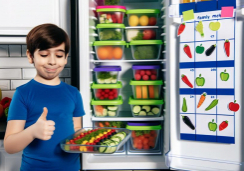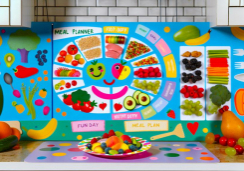10 Simple Low-Carb Meal Plans for Newbies
You've heard the buzz, seen the results, and now you're ready to take the plunge into a lower-carb lifestyle. Embarking on this journey, you'll encounter a plethora of meal choices, each more tempting and nutritious than the last.
Crafting a successful low-carb meal plan doesn't have to be an arduous task; in fact, simplicity can be your best ally. As you flip through these 10 straightforward meal plans, you'll discover not just the ease of low-carb living but the pleasure and satisfaction that come with it.
While the thought of revamping your diet may seem daunting, know that each page turned is a step towards mastering the art of low-carb cuisine and transforming your health—what awaits is a new level of culinary ease you might not have thought possible.
Understanding Low-Carb Basics
Embarking on a low-carb diet means you'll limit foods rich in carbohydrates, like sweets and refined grains, to potentially reap health benefits such as weight loss and improved blood sugar control. Low-carb diets focus on reducing the intake of carb-containing foods, which can lead to a decrease in calorie consumption and thus contribute to weight loss. A typical low carbohydrate diet consists of less than 26% of total daily calories from carbs. This often translates to fewer than 130 grams of carbs per day, though specific low-carb diets may vary.
Examples of low carbohydrate diets include the ketogenic diet, which is very low in carbs and high in fats, and the Atkins diet, which starts with a strict low-carb phase. Other plans like the Paleo and Dukan diets also limit carbs, but their rules and restrictions differ. It's important to understand that not all carbs are equal; focusing on high-quality, nutrient-dense carb sources like vegetables and whole grains, when included, is crucial for maintaining overall health.
Planning Your Grocery List
To set yourself up for success on a low-carb diet, start by crafting a grocery list that emphasizes lean proteins, leafy greens, and healthy fats while steering clear of high-carb staples. Your low-carb meal plan will thrive on foods like skinless poultry, fish, eggs, and non-starchy veggies such as broccoli and spinach. Add nuts, seeds, and oils like olive or avocado for your needed fats.
When you're shopping, prioritize fresh produce. This doesn't just support your low-carb goals; it's also a cornerstone of a nutrient-rich diet. Don't let high-carb temptations like bread, pasta, and sugary snacks derail you. Instead, include low-carb snacks and ingredients for quick meals that'll keep you satisfied and on track.
To optimize your grocery list, consider buying in bulk. This approach can be cost-effective and ensures you've always got low-carb options at hand. Before you head out, check your pantry and fridge. Use what you already have to avoid unnecessary purchases and to help plan your meals around existing items.
Day One Meal Breakdown
As you embark on your low-carb journey, it's crucial to understand how each meal contributes to your goals.
Your breakfast with Avocado Egg Delight packs healthy fats and proteins to kickstart your metabolism.
The Chicken Salad Mix for lunch offers a lean protein source with a variety of vegetables for essential nutrients.
For dinner, Grilled Salmon Magic provides a hearty dose of omega-3 fatty acids, crucial for heart health and cognitive function.
Breakfast: Avocado Egg Delight
Kickstart your low-carb journey with the Avocado Egg Delight, a breakfast that masterfully combines creamy avocado and protein-rich eggs to fuel your morning. This dish is a cornerstone of your low carb meal plan, expertly crafted to meet your dietary needs without sacrificing flavor or satisfaction.
Designed by registered dietitians, the Avocado Egg Delight supports your health goals by providing essential nutrients without the unnecessary carbs often found in traditional breakfasts.
Enjoy the harmony of healthy fats from the avocado and the high-quality protein from the eggs, which work together to keep you satiated. You can also add a side of non-starchy vegetables for added fiber and micronutrients, ensuring a balanced, nutrient-dense start to your day.
Lunch: Chicken Salad Mix
After savoring the Avocado Egg Delight for breakfast, continue your low-carb journey with a Chicken Salad Mix for lunch, offering a blend of satiating protein and refreshing greens to power through your afternoon. This meal is a cornerstone of your low carb diet plan, delivering the essential nutrients without the excess carbohydrates.
As part of your meal plan, the Chicken Salad Mix isn't only a quick option but also a versatile one. You can prepare it in advance, ensuring convenience during your busy day. Customize it with various low-carb toppings to suit your taste, while maintaining the integrity of your low carb meals.
Rich in protein and healthy fats, this lunch will keep you full and satisfied, curbing any cravings and supporting your dietary goals.
Dinner: Grilled Salmon Magic
Cap off your day with Grilled Salmon Magic, a dinner that combines the healthful richness of omega-3 fatty acids with the satisfying crunch of fresh mixed vegetables, all enhanced with the aromatic flavors of herb butter. This healthy low-carb dish is a cornerstone of simple low-carb recipes and meal plans that prioritize your well-being.
Here's why you'll love it:
- Rich in Omega-3s: Salmon is packed with these essential fats, crucial for heart and brain health.
- High Protein Content: Each serving delivers ample grams of protein to support muscle maintenance and satiety.
- Fiber-Rich Veggies: The mixed vegetables ensure you're getting your necessary fiber, aiding digestion.
- Simple and Customizable: The recipe is easy to follow and can be tailored with your favorite low-carb veggies.
Easy Low-Carb Breakfast Ideas
Begin your morning with a nutritious scramble of eggs, spinach, and feta cheese for a simple and satisfying low-carb breakfast. This combination not only aligns with a low-carb diet but also packs a punch with high-quality protein, essential vitamins, and minerals. Eggs are a cornerstone of eating low carb, providing satiety and energy to kickstart your day.
For a creamy twist, mix Greek yogurt with fresh berries and a sprinkle of nuts. This meal is rich in probiotics and antioxidants, supporting digestive health while adhering to low carb foods. The nuts add a crunchy texture and are a great source of healthy fats that can help you feel full longer.
If you're in a rush, a low-carb smoothie can be a lifesaver. Blend unsweetened almond milk, your choice of protein powder, and a handful of spinach for a refreshing and nutritious drink. It's an excellent way to incorporate greens subtly.
On days when you're prepping on the go, low-carb muffins made with almond flour and a sugar substitute are perfect low carb snacks. They're portable and customizable with various add-ins.
Lastly, a hearty low-carb breakfast skillet with sautéed veggies, bacon or sausage, and melted cheese can provide a balanced and fulfilling start to your day, keeping you energized and focused without the carb overload.
Light and Satisfying Lunches
Having kick-started your day with a low-carb breakfast, you'll want to maintain that momentum with a light yet satisfying lunch that continues to support your health goals. When you're on low carb diets, it's crucial to select meals that are both enjoyable and in line with your objectives. Your meal plan serves as your roadmap to success, guiding you to eat low-carb foods that are rich in nutrients and flavor.
Here are four light and satisfying lunch ideas to keep you energized and on track:
- Salad with Lean Protein: Top a bed of leafy greens with grilled chicken or turkey. This combination isn't only tasty but also keeps you full and focused.
- Low-Carb Wraps: Use low-carb tortillas or large lettuce leaves to make wraps filled with your favorite proteins and veggies for an on-the-go meal.
- Vegetable Stir-Fry: A colorful stir-fry with tofu or shrimp provides a variety of nutrients without the carb load. It's a quick and easy option that won't weigh you down.
- Frittata or Crustless Quiche: Combine vegetables and protein in a frittata or quiche for a satisfying midday meal that's both low in carbs and high in flavor.
Delicious Low-Carb Dinners
As you explore low-carb dinners, consider the Easy Chicken Stir-Fry. It is a meal that's both high in protein and rich in vegetables, providing a balanced array of nutrients.
Another option to satisfy your Italian cuisine cravings is the Zesty Zucchini Spaghetti. It offers a pasta-like experience with a fraction of the carbs, making it a perfect choice for a low-carb dinner.
Lastly, the Grilled Salmon Delight is not only flavorful but also packed with omega-3 fatty acids. These fatty acids are essential for heart health, making this dish a great choice for a nutritious and delicious low-carb dinner.
Easy Chicken Stir-Fry
Dive into the flavors of an Easy Chicken Stir-Fry, a quick-to-prepare, low-carb dinner that pairs juicy chicken with a medley of fresh vegetables, all tossed in a savory stir-fry sauce.
This dish is a cornerstone for low carb eating, offering a delightful way to stay faithful to your high-protein meal plan while indulging in a dish that's both nourishing and satisfying.
Here's why you'll love making it:
- Efficiency: Ready in minutes, perfect for those hectic evenings.
- Versatility: Swap in your favorite veggies to keep things exciting.
- Nutrition: Packed with protein and fiber to keep you on track.
- Flavor: A robust stir-fry sauce that brings the dish to life.
An easy chicken stir-fry doesn't just fill your plate; it fuels your body with the right balance of nutrients.
Zesty Zucchini Spaghetti
Transform your pasta night with Zesty Zucchini Spaghetti, an innovative low-carb dinner that substitutes traditional noodles with spiraled zucchini, offering a nutrient-rich meal loaded with flavor.
As you embark on a low-carb diet, it's essential to find meals that satisfy your taste buds without overloading on carbs. Zucchini spaghetti fits perfectly into low-carb meal plans, bringing a delightful twist to a classic dish.
The vibrancy of fresh zucchini paired with your favorite savory sauces provides a guilt-free way to enjoy comfort food. Plus, it's incredibly easy to prepare. You can customize it with lean proteins or healthy fats, aligning with your dietary goals while keeping the meal enjoyable.
Grilled Salmon Delight
Building on the foundation of nutrient-rich meals like Zesty Zucchini Spaghetti, Grilled Salmon Delight offers another superb option for those seeking satisfying, low-carb dinners. This dish isn't just about cutting carbs; it's packed with benefits that make it a star in low-carb diets:
- High in Protein: Keeps you full and fuels muscle repair.
- Rich in Omega-3 Fatty Acids**: Good for your heart and overall health.
- Simple to Prepare: Quick, no-fuss cooking for a busy lifestyle.
- Versatile Flavor Profile**: Easily seasoned to your liking.
Grilled Salmon Delight is low in saturated fat, especially when you use olive oil, which is a healthier fat choice. It's a delicious, balanced meal that supports your health goals without skimping on flavor.
Snacking on a Low-Carb Diet
When transitioning to a low-carb diet, selecting the right snacks can make a significant difference in maintaining your nutritional goals and keeping hunger at bay. You might often find yourself hungry between meals, and it's crucial to have go-to options that align with your low-carb objectives. Instead of reaching for typical high-carb baked goods, consider snacking on sliced deli meats paired with cheese, which offers both flavor and satiety without the extra carbs.
For times when you need something quick and easy, boiled eggs are a no-cook snack that's rich in protein and fats, helping you feel full longer. If you're in the mood for something different, smoked oysters with a side of raw veggies can be a delicious alternative. These simple, no-cook plates are also perfect for meals on the go, ensuring you're never caught off guard by hunger pangs.
Low-Carb Meal Prep Tips
As you master the art of choosing satisfying low-carb snacks, it's equally important to develop a strategy for meal prepping that keeps your diet on track. Adhering to a low-carb diet can be made simpler with a few key meal prep tips:
- Plan Your Meals: Before the week starts, plan your meals to ensure they fit within your low-carb guidelines. Knowing exactly what you're eating each day helps you stay within your desired range of calories per day and macronutrients.
- Shop Strategically: Create a shopping list based on your meal plan. Stick to it to prevent impulse buys that mightn't align with your low-carb diet.
- Prep Ingredients in Advance: Spend some time chopping vegetables, cooking proteins, and portioning out snacks. This upfront effort means quicker assembly and less temptation to stray from your eating plan during a busy week.
- Portion Control: Use containers to portion out your meals and snacks. This helps control your carb intake and makes it easy to grab a meal on the go.
Navigating Dining Out
Dining out doesn't have to derail your low-carb lifestyle; with smart choices and a bit of planning, you can enjoy a meal at a restaurant without compromising your diet goals.
When you're following low-carb meal plans, it's essential to look for dishes that are rich in protein and low in carbs. Opting for meat or fish-based main dishes is a reliable way to keep the carb count low. This simple switch helps you stay on track with your nutrition targets while still savoring the experience of eating out.
Be vigilant about hidden carbs in beverages; choose water or unsweetened drinks over sugary options that are high in carbs. If your meal comes with bread or potatoes, don't hesitate to ask for extra vegetables or a side salad instead. This substitution keeps you back on carbs and adds nutrient-dense foods to your plate.
Before heading out, check the restaurant's menu online to identify low-carb options. This forethought allows you to eat on a low-carb regimen without the stress of making snap decisions at the table.
Monitoring Your Progress
As you embark on your low-carb journey, it's essential to track your dietary changes meticulously.
Regularly measuring your health improvements, such as weight loss and body composition, provides concrete feedback on your progress.
Remember to consult with a healthcare professional to ensure your meal plan aligns with your nutritional needs and health goals.
Track Dietary Changes
To effectively gauge the impact of your low-carb diet, it's crucial to maintain a detailed food diary that captures your daily intake and observes changes in your health and well-being. Tracking dietary changes can be straightforward if you:
- Record your daily carb intake, focusing on the quality and quantity of carbs consumed.
- Monitor the percentage of calories from carbs to ensure you're adhering to a low-carb meal plan.
- Observe any fluctuations in weight and energy levels, which can indicate how your body is responding.
- Regularly check blood sugar levels and consult with a healthcare professional to interpret the data.
Measure Health Improvements
Having established a method to track your dietary changes, you'll now want to measure the resulting health improvements to assess the efficacy of your low-carb meal plan. Regularly monitor your weight, body measurements, and energy levels to gauge your progress in weight management.
Keep a food diary to observe changes in cravings and hunger, which can indicate improved control over your appetite. For those with type 2 diabetes, tracking blood sugar levels is crucial; a low-carb diet may help stabilize these readings.
Remember to note your physical activity in a journal, as exercise is a key component of a healthy lifestyle.
Always consult with a healthcare professional to discuss risk factors and personalize your low-carb approach for optimal results.
Frequently Asked Questions
How Do I Start a Low-Carb Diet for Beginners?
To start a low-carb diet, learn carb counting methods, balance your macronutrients, and use meal timing strategies. Gradually transition your diet for sustainability, and focus on nutrient-rich foods for overall health.
What Can You Eat the First Week of a Low-Carb Diet?
You'll eat protein, non-starchy veggies, and healthy fats. To manage carb withdrawal symptoms and keto flu, stay hydrated. Practice snack portion control and learn dining out strategies to maintain your diet.
What Foods Fill You up but Are Low in Carbs?
You'll find eggs, rich in protein, offer great benefits for fullness. Prioritize fiber from veggies for satiety. Lean meats and fish are excellent protein sources to keep you satisfied with minimal carbs.
What Should I Eat on a Low-Carb Day?
On a low-carb day, focus on carb swapping strategies and prioritize protein and healthy fats. Consider intermittent fasting's impact, stay hydrated, and be mindful of sugar withdrawal symptoms for a balanced approach.
Conclusion
Now you're equipped with low-carb essentials and an array of meals to kickstart your journey. Stick to your grocery list, prep ahead, and stay hydrated.
Remember, it's about balance—enjoy dining out occasionally and monitor your progress. Embrace the changes as you form lasting, healthy habits.
With these plans, you're not just cutting carbs; you're nurturing your body and paving the way to a healthier you. Stay committed, and the results will follow.










